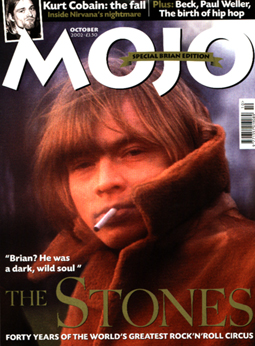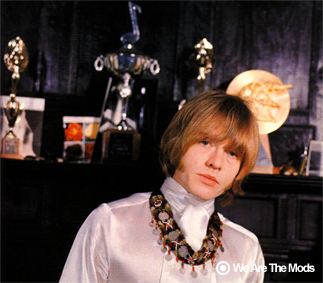
Check out the MOJO website

Check out the MOJO website
The following article was written by Gered Mankowitz and appeared in the October 2002 issue of MOJO Magazine.
Photographer Gered Mankowitz's bittersweet portrait of Brian Jones.
"The first time I met Brian Jones was at a club in Great Newport Street in late 1964. The first impression I had was of somebody who was very together, yet as I got to know him I realised he was someone with personality flaws. He was capable of being very difficult, though when I first met him he couldn't have been nicer. He was charming, extraordinarily good looking, vivacious - the most charismatic member of the band at that point, the star. Brian was very striking; he had that gorgeous blond hair, he had that pop star physique of broad shoulders but very small hips. He had a weakness for those wide-check trousers and roll-neck sweaters, quite a dandy. But it was also clear that he enjoyed the darker side of being in a pop group.
Back then, the experience of being in a band was very shared; this was a time when they had to grin and bear the rather crude backstage facilities and hotels. The routine was gruelling. No one stood up as the funny man; no one was particularly the life and soul of the party. Mick was coming into his own; Keith was still in formation; Charlie had that cool East Coast jazz look to him; Bill was just Bill - there's no other way to describe him.
When I toured America with them in 1965, I noticed he had a manipulative side - he manoeuvred people into situations so they'd respond in such a way that would satisfy his paranoid idea of what everybody thought of him. He was quite unstable on occasions, and you never quite knew what you were going to get: nice Brian or nasty Brian. He could be quite cutting and sarcastic. As time went on, it got worse and that dual personality became even more pronounced. He was becoming more experimental in his attitude to drugs, and harder and harder to handle. He was so out of it sometimes he couldn't play or he had to be propped up in the studio. Sometimes he collapsed - it was quite tragic.
The Stones were five individuals, and certainly in 1965 he was a crucial part of the band. Then suddenly, when they were on the tour, something would go wrong - he'd play badly or whatever - and Ian Stewart, the roadie/pianist, would have a go at him. I mean, he really did have a go, shouting at him about letting the group down, letting the side down.
I think people started to get irritated with him, especially because he was becoming increasingly unreliable. One just felt there was a squandering of this extraordinary talent, which was very sad.
I saw him explode a couple of times. It was pretty ghastly to see if you're not used to that sort of thing. He was very vulnerable, and it was very difficult to know how to help him, because he could be so cruel and sarcastic. He manoeuvred you into a situation where you weren't going to give a shit about him.
There are some shots in my book of Brian's flat in South Kensington. It was littered with piles of clothes and books. There was a mural on his wall, which pictured an unnamed tombstone; Marianne Faithfull says in her book that everybody knew that tombstone was Brian's. The other picture shows his rather Gothic mantelpiece with all the awards on it; it was a bourgeois, rather normal thing to have. That summed up Brian, really. On one hand the ordinary, elegant middle-class young man, and the other the dark, wild, unfathomable, extraordinary person.

On the shoot for 'Between The Buttons' [in late 1966], which was done on Primrose Hill at 5am, he looked very rough, with huge bags under his eyes. Unshaven. Someone who hadn't slept for a long time. On that shoot he was rather difficult. He was a curious, ethereal presence and there were moments when I thought he was going to ruin the whole session. He was hiding behind the collar of his coat and turning away from the camera. It was a session that had to be done quite quickly as it was very cold; but Andrew Oldham told me not to be worried, because whatever Brian did would represent the band at that time. Once I realised that it didn't matter what Brian did, it was fine.
At the end, Brian just became unreliable. He was getting more into drugs and alcohol. He had his little entourage - Tom Keylock, the Stones' driver, who always poured him into the back of the Rolls and took him home at the end of the night; then there was Anita plus other, more sycophantic hangers-on. It wasn't a case that he was ousted from the band, it was a practical thing of them having to rely on others to do his job. I never sensed that the others ganged up on him. I never saw that. The last time I saw him? Possibly the Ad Lib club in 1968 - I don't have any vivid recollections. I don't think I even went up and talked to him. Ultimately, Brian's death in '69 was a waste of genuine talent."

Photos by Gered Mankowitz.